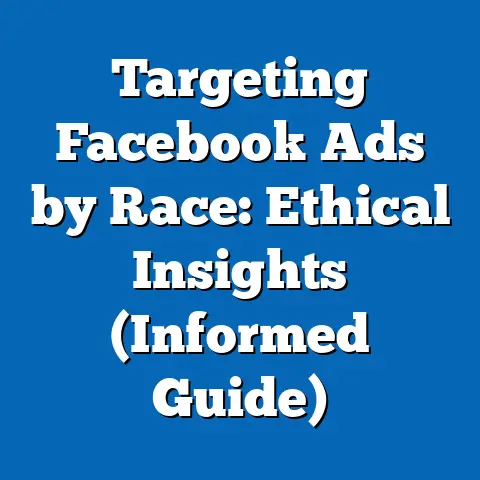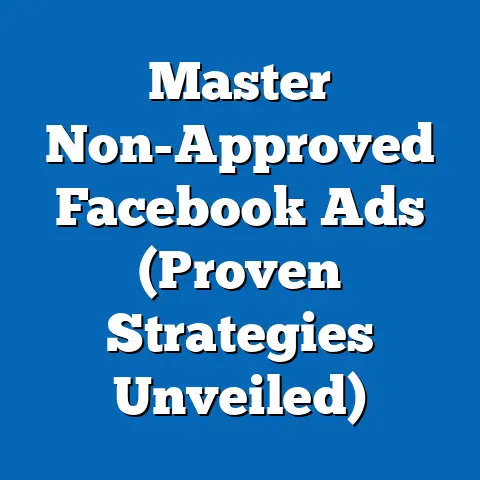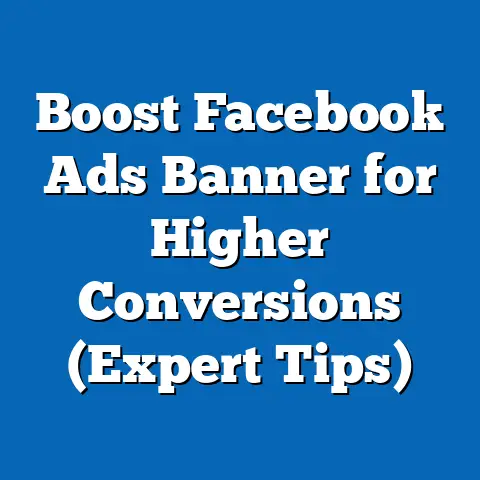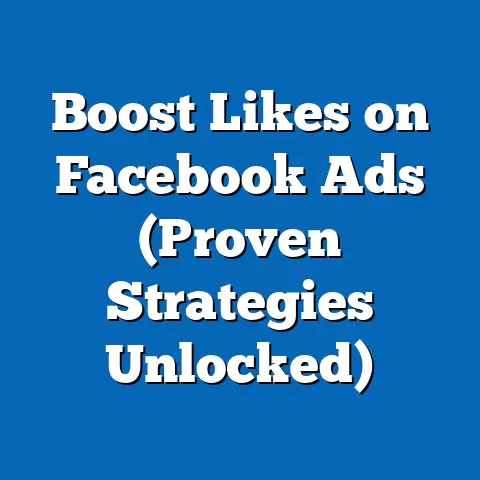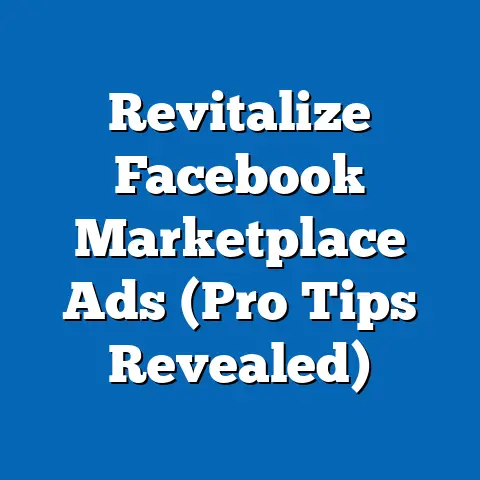Prevent Facebook Ads Failures (Proven Strategies Revealed)
Would you rather spend hundreds of dollars on Facebook ads with little to no return, or invest wisely in proven strategies that guarantee results? I know which one I’d choose!
In today’s digital landscape, Facebook advertising stands as a powerhouse for businesses of all sizes. With billions of active users, the platform offers unparalleled reach and the potential to connect with a highly targeted audience. However, the road to Facebook advertising success is often paved with pitfalls. Many businesses pour their marketing budget into campaigns that yield disappointing results, leaving them frustrated and questioning the value of the platform.
But here’s the truth: Facebook advertising isn’t inherently flawed. The failures often stem from a lack of understanding of common mistakes and a failure to implement proven strategies. I’ve seen countless businesses transform their results by simply avoiding these common traps and embracing a more strategic approach.
Understanding Common Facebook Ads Mistakes
Before diving into the solutions, it’s crucial to understand the common blunders that plague Facebook advertising campaigns. I’ve seen these mistakes repeated time and again, costing businesses valuable time and money. By recognizing these pitfalls, you can proactively avoid them and set your campaigns up for success.
-
Lack of Clear Objectives: This is, without a doubt, the most common mistake I see. Many businesses launch Facebook ads without a clear understanding of what they want to achieve. Are you looking to increase brand awareness, generate leads, drive website traffic, or boost sales? Without a specific goal in mind, it’s impossible to measure success and optimize your campaigns effectively. It’s like setting sail without a destination – you might end up somewhere, but it’s unlikely to be where you intended.
-
Poor Audience Targeting: Facebook offers incredibly granular targeting options, but many advertisers fail to leverage them effectively. Spraying your message to a broad, undefined audience is a surefire way to waste your ad spend. Imagine trying to sell vegan cookbooks to a group of avid carnivores – it’s just not going to work. Understanding your target market, their interests, demographics, and behaviors is essential for reaching the right people with the right message.
-
Neglecting Ad Creatives: In the crowded digital landscape, your ad creatives are your first impression. Dull, uninspired visuals and lackluster copy will simply get lost in the noise. Your ads need to be eye-catching, engaging, and relevant to your target audience. Think of your ad creatives as your sales pitch – you need to grab attention and convince people to take action.
-
Ignoring Analytics: Launching a Facebook ad campaign and then ignoring the data is like driving with your eyes closed. Facebook provides a wealth of data on your ad performance, including impressions, clicks, conversions, and cost per result. Failing to monitor these metrics means you’re missing out on valuable insights that can help you optimize your campaigns and improve your ROI. I’ve seen campaigns go from failing to thriving simply by paying attention to the data and making informed adjustments.
Lack of Clear Objectives: This is, without a doubt, the most common mistake I see. Many businesses launch Facebook ads without a clear understanding of what they want to achieve. Are you looking to increase brand awareness, generate leads, drive website traffic, or boost sales? Without a specific goal in mind, it’s impossible to measure success and optimize your campaigns effectively. It’s like setting sail without a destination – you might end up somewhere, but it’s unlikely to be where you intended.
Poor Audience Targeting: Facebook offers incredibly granular targeting options, but many advertisers fail to leverage them effectively. Spraying your message to a broad, undefined audience is a surefire way to waste your ad spend. Imagine trying to sell vegan cookbooks to a group of avid carnivores – it’s just not going to work. Understanding your target market, their interests, demographics, and behaviors is essential for reaching the right people with the right message.
Neglecting Ad Creatives: In the crowded digital landscape, your ad creatives are your first impression. Dull, uninspired visuals and lackluster copy will simply get lost in the noise. Your ads need to be eye-catching, engaging, and relevant to your target audience. Think of your ad creatives as your sales pitch – you need to grab attention and convince people to take action.
Ignoring Analytics: Launching a Facebook ad campaign and then ignoring the data is like driving with your eyes closed. Facebook provides a wealth of data on your ad performance, including impressions, clicks, conversions, and cost per result. Failing to monitor these metrics means you’re missing out on valuable insights that can help you optimize your campaigns and improve your ROI. I’ve seen campaigns go from failing to thriving simply by paying attention to the data and making informed adjustments.
Key Takeaway: Recognizing these common mistakes is the first step towards preventing Facebook ads failures. By understanding where things often go wrong, you can proactively address these issues and set your campaigns up for success.
Proven Strategies to Prevent Failures
Now that we’ve identified the common pitfalls, let’s dive into the proven strategies that can help you avoid these mistakes and achieve your Facebook advertising goals. These strategies are based on my own experience managing countless Facebook ad campaigns, as well as insights from industry experts and successful businesses.
Setting Clear Objectives
The foundation of any successful Facebook ad campaign is a well-defined objective. Before you even think about creating an ad, you need to ask yourself: What do I want to achieve with this campaign?
I always recommend using the SMART framework to define your objectives:
- Specific: Your objective should be clear and well-defined. Instead of saying “I want to increase brand awareness,” try “I want to increase brand awareness among women aged 25-34 who are interested in sustainable fashion.”
- Measurable: You need to be able to track your progress and determine whether you’re achieving your objective. This means defining specific metrics that you’ll monitor. For example, “I want to increase website traffic by 20%.”
- Achievable: Your objective should be realistic and attainable. Setting unrealistic goals can lead to discouragement and wasted effort.
- Relevant: Your objective should align with your overall business goals. Make sure your ad campaigns are contributing to the bigger picture.
- Time-bound: Set a deadline for achieving your objective. This will help you stay focused and motivated. For example, “I want to generate 50 leads within the next month.”
Here are some examples of well-defined objectives for Facebook ad campaigns:
- Increase website traffic: Drive more visitors to your website to increase brand awareness and generate leads.
- Generate leads: Collect contact information from potential customers to nurture them through your sales funnel.
- Boost sales: Drive direct sales through your website or online store.
- Promote an event: Increase attendance at a webinar, conference, or other event.
- Increase app installs: Encourage users to download your mobile app.
Key Takeaway: Defining clear, SMART objectives is crucial for guiding your Facebook ad campaigns and measuring your success. Start with a clear goal in mind, and you’ll be much more likely to achieve it.
Mastering Audience Targeting
Facebook’s targeting capabilities are incredibly powerful, but they can also be overwhelming. To effectively target your audience, you need to understand your ideal customer inside and out.
Start by creating a detailed buyer persona. This is a fictional representation of your ideal customer, based on research and data about your existing customers. Include information like their demographics, interests, behaviors, pain points, and goals.
Once you have a clear understanding of your target audience, you can leverage Facebook’s targeting options to reach them effectively. Here are some of the most powerful targeting features:
- Custom Audiences: These allow you to target people who have already interacted with your business, such as website visitors, email subscribers, or customers. This is a great way to retarget people who are already familiar with your brand. I’ve found that retargeting campaigns often have a much higher conversion rate than targeting cold audiences.
- Lookalike Audiences: These allow you to target people who are similar to your existing customers. Facebook uses its algorithm to identify users who share similar characteristics, interests, and behaviors with your Custom Audiences. This is a great way to expand your reach and find new customers who are likely to be interested in your products or services.
- Detailed Targeting: This allows you to target people based on their demographics, interests, behaviors, and connections. You can target people based on their age, gender, location, education, job title, interests, hobbies, and much more.
A/B testing is essential for audience targeting. Don’t just assume that you know what audience will be most responsive to your ads. Create multiple ad sets with different targeting options and track their performance to see which audiences are most engaged.
Key Takeaway: Understanding your target audience and leveraging Facebook’s targeting features effectively is crucial for reaching the right people with the right message. Use Custom Audiences, Lookalike Audiences, and detailed targeting options to refine your audience and improve your ROI.
Creating Compelling Ad Creatives
In the fast-paced world of social media, you have mere seconds to capture someone’s attention. That’s why your ad creatives need to be visually appealing, engaging, and relevant to your target audience.
Here are some tips for designing visually appealing ads that capture attention:
- Use high-quality images and videos: Blurry, pixelated images and videos will instantly turn people off. Invest in professional photography or videography to create visually stunning ads.
- Use color psychology: Colors can evoke different emotions and associations. Choose colors that are consistent with your brand and that will resonate with your target audience. For example, blue can convey trust and reliability, while red can convey excitement and energy.
- Keep it simple: Avoid cluttering your ads with too much text or too many elements. Focus on a clear, concise message and a strong call to action.
- Use motion: Motion graphics and videos are more likely to grab attention than static images. Consider using short, engaging videos to showcase your products or services.
Storytelling is key to engaging ad copy. Instead of just listing features and benefits, tell a story that resonates with your audience. Highlight the problem your product or service solves and how it can improve their lives.
Here are some tips for writing compelling ad copy:
- Focus on the benefits, not just the features: Tell people what your product or service can do for them.
- Use a strong call to action: Tell people exactly what you want them to do, whether it’s visiting your website, signing up for a free trial, or making a purchase.
- Keep it concise: People have short attention spans, so get to the point quickly.
- Use humor: If appropriate for your brand, humor can be a great way to engage your audience and make your ads more memorable.
Key Takeaway: Creating compelling ad creatives is essential for capturing attention and driving results. Use high-quality visuals, concise copy, and a strong call to action to make your ads stand out from the crowd.
Utilizing Analytics for Continuous Improvement
Facebook provides a wealth of data on your ad performance, and it’s crucial to monitor these metrics to optimize your campaigns and improve your ROI.
The first step is to set up Facebook Pixel. This is a small piece of code that you place on your website to track conversions and other actions that people take after clicking on your ads. With Facebook Pixel, you can track website visits, purchases, lead submissions, and other important events.
Here are some key performance indicators (KPIs) to monitor:
- Impressions: The number of times your ad was shown to people.
- Reach: The number of unique people who saw your ad.
- Click-Through Rate (CTR): The percentage of people who clicked on your ad after seeing it.
- Conversion Rate: The percentage of people who completed a desired action (e.g., made a purchase, submitted a lead form) after clicking on your ad.
- Cost Per Click (CPC): The average cost you pay for each click on your ad.
- Cost Per Conversion (CPC): The average cost you pay for each conversion.
- Return on Ad Spend (ROAS): The amount of revenue you generate for every dollar you spend on advertising.
Use this data to make informed decisions about your campaigns. If you see that your CTR is low, it might be a sign that your ad creatives aren’t engaging enough. If your CPC is high, you might need to refine your targeting options. If your conversion rate is low, you might need to improve your landing page or your offer.
A/B testing is essential for continuous improvement. Test different ad creatives, targeting options, and bidding strategies to see what works best for your business.
Key Takeaway: Monitoring your ad performance and making data-driven decisions is crucial for optimizing your campaigns and improving your ROI. Use Facebook Pixel to track conversions, monitor key KPIs, and A/B test different elements of your campaigns to see what works best for your business.
Real-World Case Studies
Let’s take a look at a few real-world examples of businesses that successfully implemented these strategies and achieved impressive results with their Facebook ad campaigns.
Case Study 1: Local Restaurant
- Challenge: A local restaurant was struggling to attract new customers.
- Strategy: The restaurant defined a clear objective: to increase reservations by 20% within the next month. They targeted their audience based on their location, interests in food and dining, and demographics. They created visually appealing ads featuring their most popular dishes and a strong call to action to book a reservation. They also monitored their ad performance closely and made adjustments based on the data.
- Results: The restaurant increased reservations by 25% within the first month.
Case Study 2: E-commerce Store
- Challenge: An e-commerce store was experiencing low conversion rates.
- Strategy: The store defined a clear objective: to increase conversion rates by 10% within the next quarter. They retargeted website visitors who had added items to their cart but didn’t complete the purchase. They created compelling ads featuring the products they had abandoned and offered a discount to encourage them to complete the purchase. They also A/B tested different ad creatives and landing pages to see what worked best.
- Results: The e-commerce store increased conversion rates by 15% within the first quarter.
Case Study 3: Online Course Provider
- Challenge: An online course provider was struggling to generate leads.
- Strategy: The provider defined a clear objective: to generate 100 leads within the next two weeks. They targeted their audience based on their interests in online learning, career development, and specific industries. They created compelling ads featuring testimonials from satisfied students and a strong call to action to download a free e-book. They also monitored their ad performance closely and made adjustments based on the data.
- Results: The online course provider generated 120 leads within the first two weeks.
Key Takeaway: These case studies demonstrate the power of implementing proven strategies to prevent Facebook ads failures. By defining clear objectives, mastering audience targeting, creating compelling ad creatives, and utilizing analytics for continuous improvement, businesses can achieve impressive results with their Facebook ad campaigns.
Conclusion
Facebook advertising can be a powerful tool for businesses of all sizes, but it’s essential to avoid common mistakes and implement proven strategies to prevent failures.
By understanding these strategies and applying them to your own campaigns, you can significantly reduce the risk of failure and unlock the true potential of Facebook advertising.
So, take action today! Define clear objectives, master audience targeting, create compelling ad creatives, and utilize analytics for continuous improvement. The results may surprise you.
Call to Action
I’d love to hear about your experiences with Facebook ads. What challenges have you faced? What strategies have worked well for you? Share your thoughts in the comments below!
If you’re struggling with your Facebook ad campaigns and need personalized advice, don’t hesitate to reach out. I’m here to help you achieve your advertising goals and transform your Facebook ads from a money pit into a profit center.

